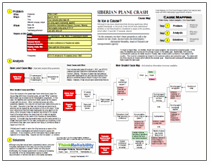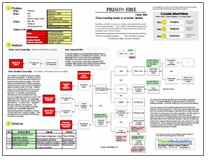Flying into a small airport surrounded by mountains at night, in a thunderstorm, with virtually no support from ground equipment proved to be too difficult for even an experienced pilot.
All 113 passengers and crew on Air France Flight 117 were killed when the plane crashed into a hill near the airport in Point-à-Pitre, Guadeloupe on June 22, 1962. The crash occurred in the early morning hours, during a severe thunderstorm. We can examine the causes of this tragedy in a Cause Map, a visual form of root cause analysis that shows the cause-and-effect relationships that led to an incident such as this one. The VHF (very high frequency) omnidirectional range (VOR) indicator, which helps aircraft determine position and stay on course, at the airport in Guadeloupe was not functional. (It’s not clear if the crew of the Air France flight was aware of this, or how long the equipment had been broken.) The plane in question was a Boeing 707.
 The safety goal was impacted because all people onboard the plane – passengers and crew – were killed. The plane (valued at $5.5 million) was completely destroyed. The lack of a working VOR, and the incorrect information provided by the Automatic direction finder (ADF) can be considered impacts to the customer service goal. Beginning with the impacted safety goal, we can ask “Why” questions to begin mapping cause-and-effect relationships. The passengers and crew were killed (and the plane destroyed) when the plane crashed into a hill.
The safety goal was impacted because all people onboard the plane – passengers and crew – were killed. The plane (valued at $5.5 million) was completely destroyed. The lack of a working VOR, and the incorrect information provided by the Automatic direction finder (ADF) can be considered impacts to the customer service goal. Beginning with the impacted safety goal, we can ask “Why” questions to begin mapping cause-and-effect relationships. The passengers and crew were killed (and the plane destroyed) when the plane crashed into a hill.
The plane crashed into a hill because the airport was surrounded by mountains, and the plane strayed off the let down track, which it should have used for its approach to the airport. The pilot went off track because he was using a visual approach, probably due to the fact that the VOR was not providing data since it was not working. The pilot was unable to see the track due to low (10 km) visibility and since it was early morning (~4 a.m.). In addition, the plane received incorrect position indication from the ADF, which appeared to malfunction as a result of the severe thunderstorm in the area.
This incident resulted in concern from pilots of substandard landing conditions at certain airports. More care is now taken with take-off and landing during inclement weather, poor visibility, or conditions that result in landing with decreased equipment support.
To view the Outline and Cause Map, please click “Download PDF” above.









